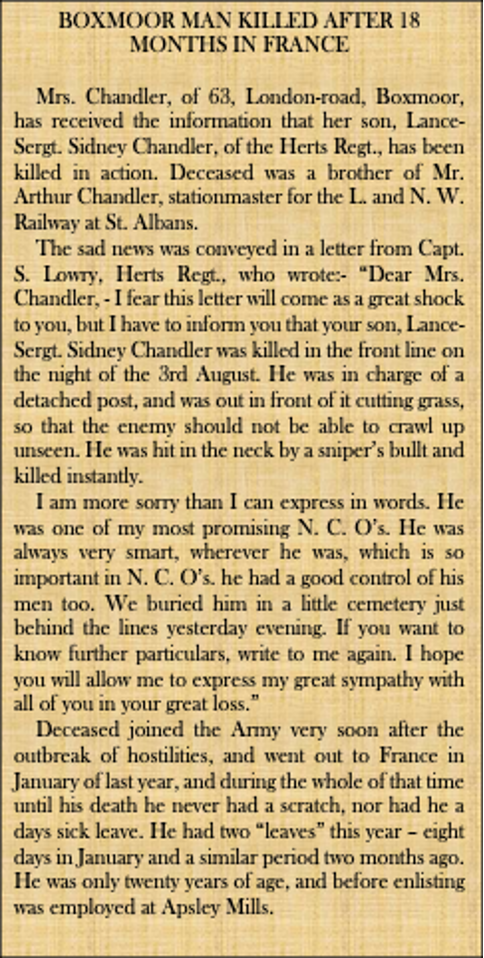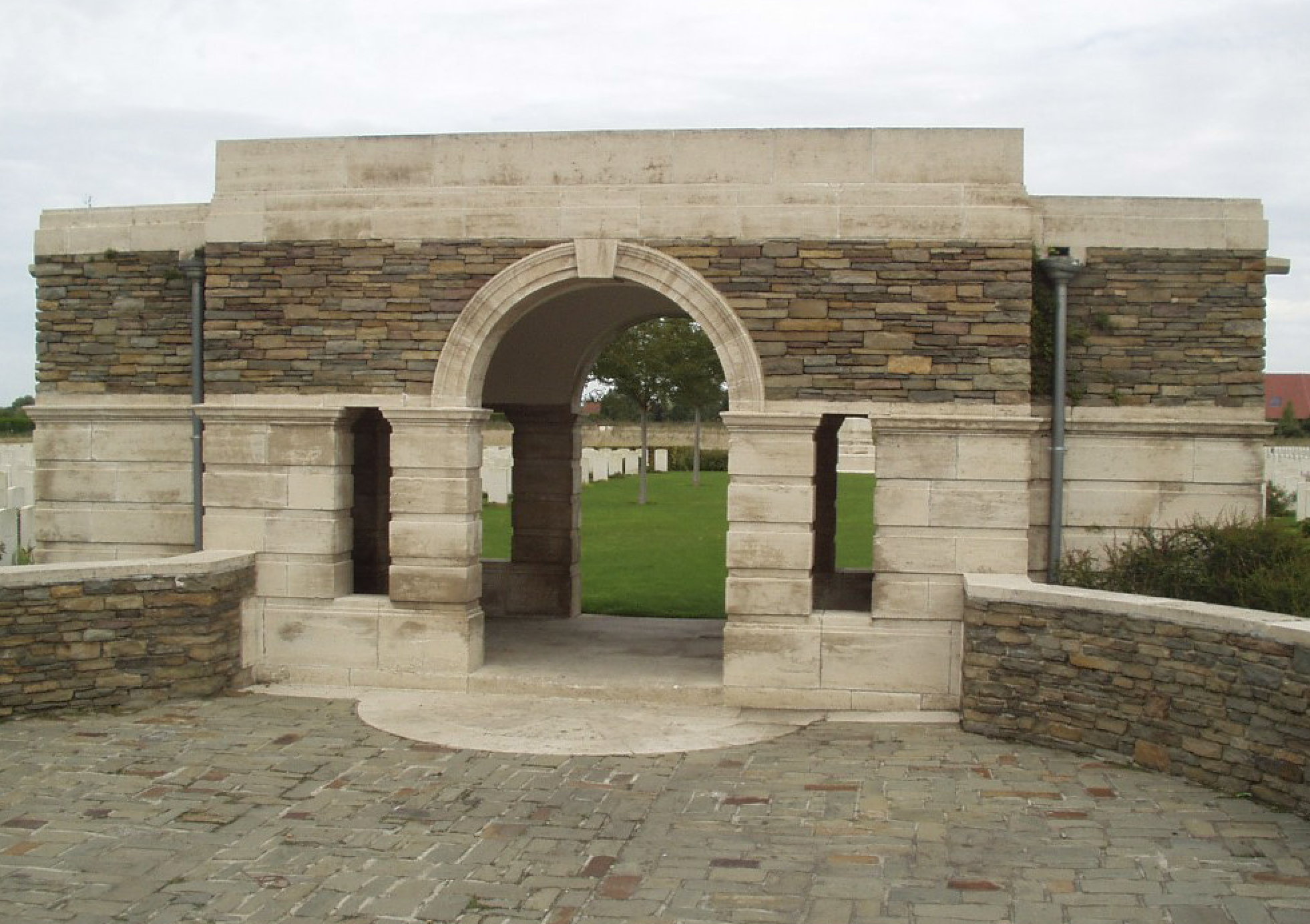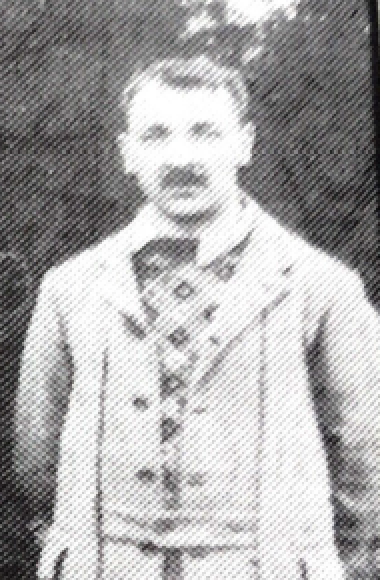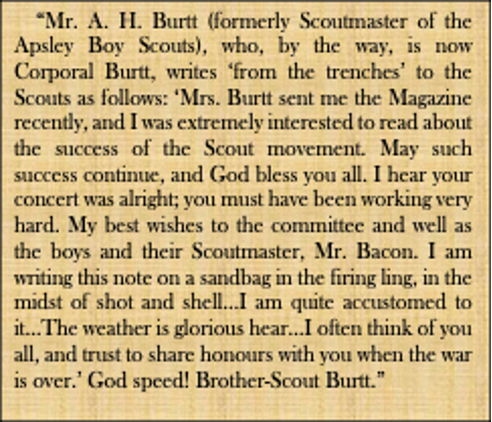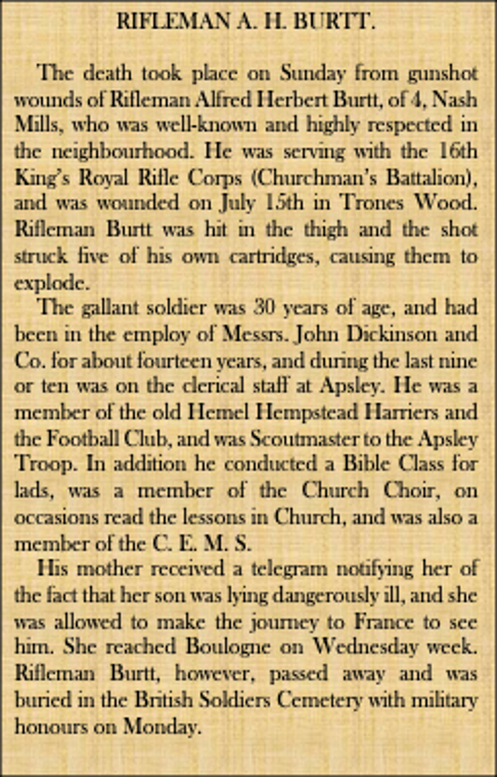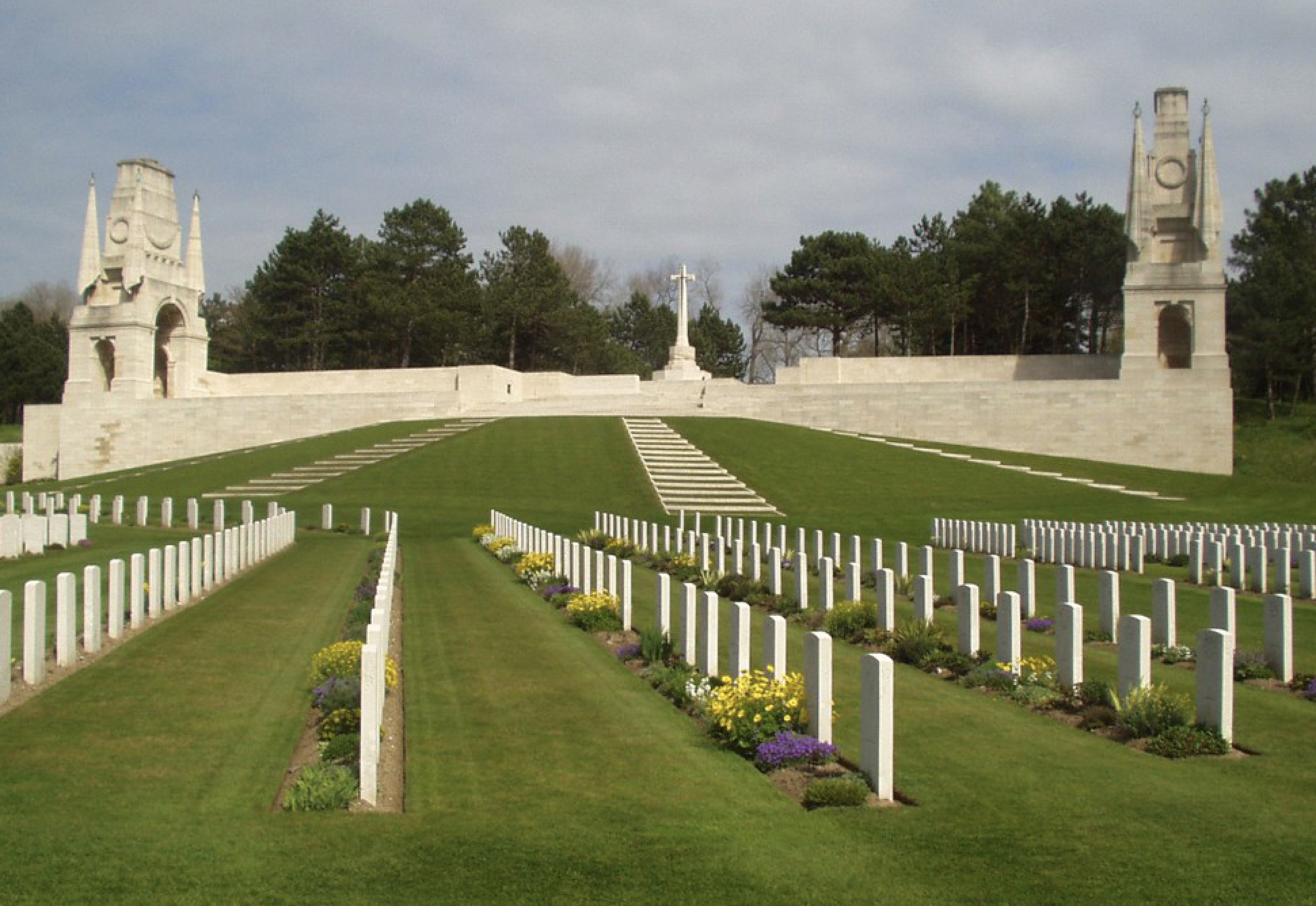Fallen in August 1916:
Sidney Chandler
Alfred Henry Burtt
Walter Henry Croft
SIDNEY CHANDLER
2860 Lance Serjeant
1st Bn., Hertfordshire Regiment
Killed in Action Friday, 4th August 1916
Remembered with Honour, Brown's Road Military Cemetery, Festubert, Pas-de-Calais, France, Grave II.A.15
Sidney Chandler was born in October 1895 in Boxmoor near Hemel Hempstead the tenth child of Alfred Chandler and Susan Fountain. Alfred and Susan had thirteen children and there was over twenty-three years between the oldest and youngest. The children were: Jesse, Frederick, Arthur, Sarah Anne, Alfred, George, Marion, Joseph, Thomas, William Frank, Harry, Sidney and Archibald Bernard.
Three of the children died young, Joseph in 1893 aged three, Harry in 1898 aged four and one other at an unknown date. Thomas also fought and died in the Great War. He was killed only two months after Sidney in October 1916 and his biography also appears on this site.
Sidney’s father Albert was a ‘Platelayer’ working for the London and North Western Railway and had brought his family to Boxmoor near Hemel Hempstead in the early 1890’s.
By the time of Sidney’s birth, the family were living at 63 London Road, Boxmoor in the ‘Railway Cottages’. In 1911, fifteen-year-old Sidney had started work as a ‘Clerk’ in Apsley Paper Mills with John Dickinson & Co. Limited. His older brothers Arthur and Thomas worked for the London North Western Railway as ‘Station-Master’ at St. Albans and ‘Porter’ at Bletchley respectively.
On the outbreak of war, Sidney travelled to Hertford where he attested on the 7th September 1914 and joined the 1/1st Battalion Hertfordshire Regiment. On enlistment, Sidney was described as 5ft 3½ins tall, with a ‘Fresh’ complexion, blue eyes and fair hair. He was immediately sent to Bury St Edmunds to train and remained there until the start of 1915 when he went to France.
The 1st Battalion Hertfordshires served in the 4th (Guards) Brigade of the veteran 2nd Division and because of this attachment, they were sometimes referred to as the "Hertfordshire Guards" and adopted many of the Guards peculiarities as a result, including naming their Companies by number rather than letter.
Whilst serving in the 4th Brigade, the battalion fought alongside the following other Guards battalions: the 2nd Battalion, the Grenadier Guards; the 2nd Battalion, the Coldstream Guards; the 3rd Battalion, the Coldstream Guards; and the 1st Battalion, the Irish Guards.
Sidney disembarked in France on the 23rd January 1915 and joined the Battalion at Beuvry east of Béthune on the 31st January as part of a draft of "2 Officers and 190 O.Rs". He saw his first significant action in May at the Battle of Festubert where the Battalion suffered 113 casualties over two days of fighting.
In the following September, Sidney fought in the Battle of Loos where again the Battalion incurred a high number of casualties including twenty-six from gas poisoning. Sidney survived Loos and was promoted Lance Corporal in November 1915.
Sidney came home to Boxmoor for eight days in January 1916 and after his return to France he was promoted Corporal in April 1916. He had a second spell of home leave in June and was once more promoted on his return to the Front, this time to Lance Serjeant on the 14th July 1916.
On the 1st August the 1st Hertfordshires relieved the 13th Battalion Royal Sussex in the Festubert sub-section of trenches. For the next three days there was little of note other than some light enemy shelling and sniping and casualties were mercifully few.
However, Sidney was tragically killed. He was in a detached post where he had been engaged in cutting the grass in front of his position so that the enemy could not crawl up unseen. He was hit in the neck by a sniper’s bullet and killed instantly.
He died on Friday, 4th August 1916.
His death was reported in the Hemel Gazette three weeks later along with a letter from his C.O. Capt. S. Lowry, explaining the circumstances of his death and offering sympathy to the family. Capt. Lowry also describes Sidney’s character and promise which helps explain his rapid promotions in the field. (see extract)
Sidney is Remembered with Honour in Brown's Road Military Cemetery, Festubert, Pas-de-Calais, France where he is interred in Grave II.A.15
Lance Serjeant Sidney Chandler 1916 (Courtesy: The Hertfordshire, Hemel Hempstead Gazette and West Herts Advertiser)
Extract from The Hertfordshire, Hemel Hempstead and West Herts Gazette 26th Aug. 1916
Becourt Military Cemetery, Becordel-Becourt, Somme, France (Courtesy: CWGC)
He was 21 years old when he died
Sidney was entitled to the 1914-15 Star, the British War Medal and the Allied Victory Medal.
ALFRED HENRY BURTT
C/1415 Rifleman
16th Bn., King's Royal Rifle Corps
Died of Wounds Sunday, 6th August 1916
Remembered with Honour, Etaples Military Cemetery, Pas-de-Calais, France, Grave IX.C.17A
Alfred Herbert Burtt, known as Henry, was born in early 1886 in Norwich, the first child and only son of Alfred Herbert Burtt and Jane Maria ‘Annie’ Ginger. He had two younger sisters who were Emily and Daisy. His father Alfred was a ‘Commission Agent’ later known as a ‘Commercial Traveller’ and his job meant that the family moved frequently when Henry was young. In the space of ten years he lived in Norwich, then Holloway in North London before moving a short distance to Edmonton where the family lived in 1901.
By this time Henry’s father had settled into a job as a Commercial Clerk in Hays Wharf near Tooley Street in Southwark. Fifteen-year-old Henry had found employment as a ‘Grocer’s Boy’ in Edmonton. Only a year later in 1902 he started work with John Dickinson & Co. Limited, possibly at Old Bailey in London, however, it was this employment that brought him to the Hemel Hempstead area.
In 1911 he was living in Apsley as a boarder with the Garner family and working as an ‘Order Clerk’ in Apsley Mills. Henry had met Gertrude Smith from Abbots Langley while he was at Apsley Mills and on the 29th June 1912, they were married at St Mary’s Church in Apsley End.
Henry worked at John Dickinson for about fourteen years and ten of those were spent in the clerical department. It is clear from his obituary that he was enthusiastically involved in the social and sporting life of the community as well as being an active member of his local church congregation.
He was a member of Hemel Hempstead Harriers and the local football club.
He was also Scoutmaster to the Apsley troop. Indeed, the Hemel Gazette published a brief but cheerful letter he sent to the Apsley Scouts when he was at the Front. (see extract)
Henry was a member of the church choir at St Mary’s Apsley End where he also conducted a bible class for the Church Lads. He was an active member of the Church of England Men’s Society, an organisation with a strong moral voice in the early years of the 20th century over issues such as opposition to the force feeding of Suffragettes.
Henry enlisted with the 16th (Service) Battalion (Church Lads Brigade) King’s Royal Rifle Corps (KRRC), attesting at Holborn, London in September 1915. The 16th Battalion was raised at Denham in Buckinghamshire in September 1914 by Field-Marshall Lord Grenfell, Commandant of the Church Lads Brigade (CLB). It consisted exclusively of past and present members of the CLB who made perfect recruits as they had been ‘Cadets’ since 1911 and therefore trained in shooting, marching, and used to taking orders.
Henry went to France in early 1916 and by July he was in the second wave of the ‘Big Push’ at the Battle of the Somme. The 16th was ordered to attack High Wood near Delville Wood and early on Sunday, 15th July the assault began, uphill and in the open against a well-entrenched enemy. Tragically many men were mown down by enfilade fire from the Germans and despite repeated attacks it became clear by evening that the attack had failed. Eye-witness accounts state that “It was a horrible, terrible massacre….”. The Battalion incurred over 120 men killed and many more wounded.
Henry was one of the wounded by a shot in his thigh which also detonated five of his own cartridges and inflicted catastrophic damage. He was taken down the line and admitted to No.20 General Hospital, Camiers near Boulogne-sur-Mer.
His wife Gertrude was advised of his wounding and permitted to make the trip to France to see him in hospital. She arrived on the 2nd August and for the next four days Gertrude was at Henry’s bedside and able to converse with him right up until he died. Henry and Gertrude received Holy Communion at about 9pm on Sunday, 6th August 1916 from a Church of England Chaplain and Henry passed away shortly afterwards.
A touching obituary appeared in the Hemel Gazette a week later and attested to the respect local people had for Henry and described his involvement and contribution to the local community and to his church. (see extract)
Henry is commemorated on the John Dickinson & Co. Limited war memorial and in St Mary’s Church Apsley-End.
Henry is Remembered with Honour in Etaples Military Cemetery, Pas-de-Calais, France where he is interred in Grave IX.C.17A. The inscription on his headstone, requested by his wife Gertrude, reads: “FOR GOD RIGHT AND LIBERTY”.
He was 30 years old when he died
Henry was entitled to the British War Medal and the Allied Victory Medal.
Alfred Henry Burtt c1912 (Courtesy: A Football History of Apsley and Kings Langley, A.J. Taylor, 1997)
Apsley St Mary’s FC c1912, Alfred standing far right (Courtesy: A Football History of Apsley and Kings Langley, A.J. Taylor, 1997)
Extract from The Hertfordshire, Hemel Hempstead Gazette and West Herts Advertiser 8th Apr. 1916
Extract from The Hertfordshire, Hemel Hempstead Gazette and West Herts Advertiser 12th Aug. 1916
John Dickinson & Co. Limited War Memorial (Courtesy: Traquair Photography 30th Aug. 2016)
Etaples Military Cemetery, Pas-de-Calais, France (Courtesy: CWGC)
WALTER HENRY CROFT
7909 Corporal
2nd Bn., Norfolk Regiment
Died of Illness Thursday, 31st August 1916
Remembered with Honour, Baghdad (North Gate) War Cemetery, Iraq, Grave XXI.R.37.
Walter Henry Croft was born in the summer of 1889 in Botley, close to Southampton in Hampshire, the fourth of seven children born to William Croft and Martha Ann Baker. Walter’s siblings were: Sarah Ann, Emily, George, Gertrude, Alice and William Alfred. His youngest brother William also fought in the Great War and was killed at Ypres in July 1917. Their brother-in-law Bertie Parkins, who married Alice Croft, also died in France in 1917. The biographies of William and Bertie are also on this site.
When Walter was born his family lived in the charmingly named ‘Myrtle Cottage’ in School Lane, Weymouth and his father William was employed by the Devenish Weymouth Brewery as a ‘Drayman’.
By 1901 the family had moved back to the Botley area and were living at ‘Coledown’ where William was now a ‘Coachman’ at nearby ‘Coledown House’. It was William’s job as a ‘Coachman’ that brought the Croft family to Hemel Hempstead around 1906. They moved into Kemp Cottage on the Redbourn Road and William worked for the Elworthy family at ‘Grove Hill’.
Walter enlisted in the Regular Army in 1909, joining the 2nd Battalion Norfolk Regiment and by 1911 he was serving in Bombay, India in the 18th (Belgaum) Brigade, part of the 6th (Poona) Division, of the British Indian Army. On the outbreak of war, the Battalion was still in India and was mobilised and sent to Mesopotamia in November 1914. Mesopotamia was an area roughly corresponding to most of Iraq, Kuwait, parts of Northern Saudi Arabia, the eastern parts of Syria, South-eastern Turkey, and regions along the Turkish–Syrian and Iran–Iraq borders.
Throughout 1914 and most of 1915, Walter and the Norfolks experienced success in the fighting against the Ottoman forces. However, after the battle at Ctesiphon, 25 miles south of Baghdad in November, the British retreated and were pursued by the Ottomans who had also retreated but cancelled this when they saw an opportunity to chase the British.
The exhausted and depleted British force was urged back to the defenses of Kut-al-Amara and by the 3rd December the Ottomans had encircled the British and sent other forces down river to prevent reinforcements from marching to the relief of the garrison.
The siege of Kut-al-Amara began on the 7th December 1915 and lasted until the British surrender on the 29th April 1916, when the Ottomans took over 13,000 soldiers prisoner. Walter had been wounded in February and now found himself a prisoner of war.
The capitulation at Kut-al-Amara was described by one historian as "the most abject capitulation in Britain's military history” and considered by others to be the worst allied defeat in World War One.
The survivors of the siege were marched to imprisonment at Aleppo, during which many died. This followed an offer by the Ottomans to transport the men by boat, but this was rejected by the British for some reason. 70% of the British and 50% of the Indian troops died of disease or at the hands of their Ottoman guards during captivity.
Walter survived for four months before he too succumbed to illness, no doubt exacerbated by his wounds. He died in captivity on Thursday, 31st August 1916.
Corporal Walter Henry Croft (Courtesy: The Hertfordshire, Hemel Hempstead Gazette and West Herts Advertiser)
Grove Hill where Walter's father worked as a "Coachman" (Public Domian)
Baghdad (North Gate) War Cemetery, Iraq (Courtesy: CWGC)
Walter is Remembered with Honour in Baghdad (North Gate) War Cemetery, Iraq where he is interred in Grave XXI.R.37. The inscription on his headstone, requested by his mother Martha, reads: “HE DIED THAT WE MIGHT LIVE”.
He was 27 years old when he died
Walter was entitled to the 1914-15 Star, the British War Medal and the Allied Victory Medal.
